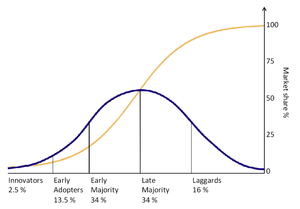Theory of innovation diffusion
| Change with digital technologies in education (#OERuCDTE) | |
|---|---|
| Arena of change | Introduction and objectives | Video Signpost | E-Activity - Mindmap | Overview of change models | Theory of innovation diffusion | E-Activity - Essay plan |
Rogers' classification of the adopter categories is frequently cited in the popular literature to account for the diffusion of new technology. Less well known is the comprehensiveness of the theory taking into account the breadth of dimensions incorporated into this work. While the strength of the theory lies in its broad foundation, it is not always easy to apply when analysing technology adoption in specific contexts. Nonetheless any study on change with digital technology would not be complete without an overview of the structural components of Rogers' theory of innovation diffusion.
Rogers' theory of innovation diffusion is structured into four primary components including: (1) the innovation, (2) communication channels, (3) social system, and (4) time. The theory also incorporates: (1) a five stage process explaining the phases of the decision making process, (2) types of decisions, (3) characteristics of the innovation which impacts on the adoption decision and (4) the rate of adoption.
When consulting Rogers' work at this stage of our learning journey, its important to avoid becoming trapped in the detail and to keep our eye focused on the forest, namely a high level overview of the structural components associated with the diffusion of technology.
Consult the following resources which will provide an overview of the components associated with the diffusion of technology. This overview is intended as a catalyst to support your thinking for refining your research topic before you commence work on preparing a draft outline for your essay.
|
Notes
- ↑ Rogers, E. M. (2003). Diffusion of innovations. New York: Free Press.

